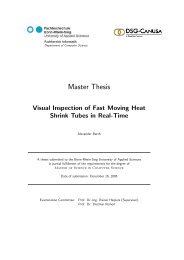Master Thesis - Hochschule Bonn-Rhein-Sieg
Master Thesis - Hochschule Bonn-Rhein-Sieg
Master Thesis - Hochschule Bonn-Rhein-Sieg
You also want an ePaper? Increase the reach of your titles
YUMPU automatically turns print PDFs into web optimized ePapers that Google loves.
2. Overview on human-robot <strong>Master</strong> <strong>Thesis</strong> Björn Ostermann page 14 of 126<br />
2.3 Overview of the project at the BGIA<br />
Prior to this master thesis two project reports have been created [77] [78], which have laid the<br />
foundation of this thesis and their results are included in this report.<br />
This chapter summarizes the complete framework project, consisting of both reports and this thesis.<br />
The overall goal of the complete project is to develop a collaborative workspace, consisting of an<br />
industrial jointed arm robot, a sensor system and a control system that allows a human operator to<br />
work safely in close proximity of the robot.<br />
In the R&D 1 report: “Development of a prototype of an autonomous motion control for assisting<br />
industrial robots” [77] several approaches to this topic were evaluated (see chapter 2.2) and a solution<br />
to the topic was developed.<br />
At the beginning of the R&D 2 project the developed theoretical approach to the above mentioned<br />
solution was discussed on the point of feasibility. An optimal tradeoff between functionality and<br />
feasibility was found, which is briefly described in chapter 2.3.1, along with the different algorithms in<br />
chapter 2.3.2 that are needed for the completion of the project in this master thesis.<br />
The hard- and software, discussed in the R&D 1 report, on which the project is implemented, was<br />
selected in the R&D 2. A description of this hard- and software, as well as its assembly in this master<br />
thesis, can be found in chapter 3.<br />
The main attention of this report is on the designed program that shows how the robot can be<br />
controlled to evade dynamic objects in its working place. Additionally, in chapter 6.4, the performance<br />
of the system is evaluated and compared to an optimal system.<br />
2.3.1 Path planning approach<br />
As described in the previous R&D 1 report [77], there are several modes of safe human-robot<br />
collaboration that can be achieved. The easiest is to separate the human and the robot completely, thus<br />
allowing no cooperation at all. The most difficult is to allow the human and the robot touching each<br />
other, while still executing tasks. To collaborate with a human, robots have to sense their complete<br />
environment and act accordingly, because safety, mainly of the human operator, is always the biggest<br />
issue.<br />
The approach described in the R&D 1 report has been designed to allow a high degree of collaboration<br />
between human and robot, enabling the human to touch and interact with the robot at all times. This<br />
approach not only puts high demands on the required hardware, using for example at least two high<br />
tech 3D cameras, but also needs a lot of computational effort, which in turn puts high demands on the<br />
processing capabilities of the logical unit.<br />
Based on the knowledge, acquired in the first report, a practical approach was found. This approach is<br />
a tradeoff between the functionality of the previously developed algorithm and the simplicity of a<br />
fence. It was develop in the R&D 2 report [78] and can best be described as a flexible fence. Human














